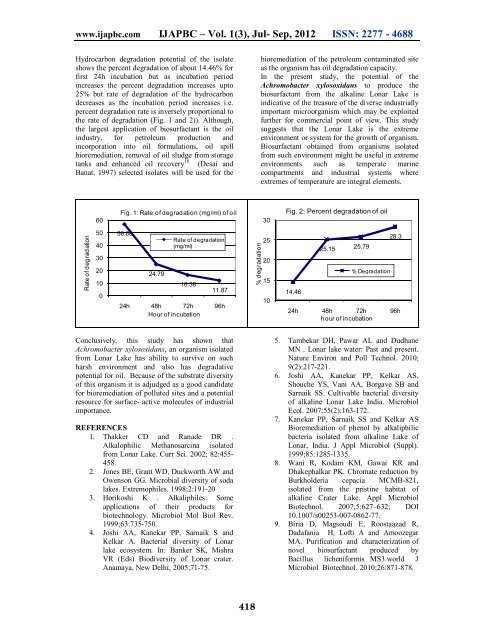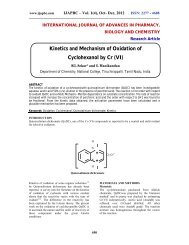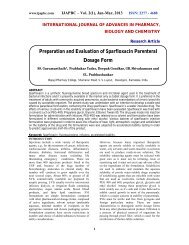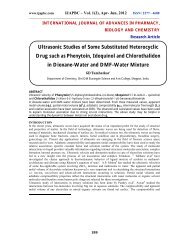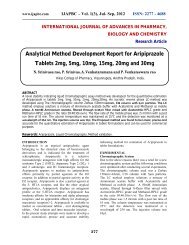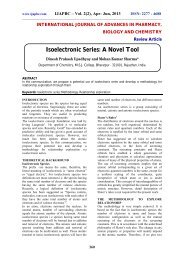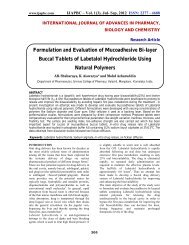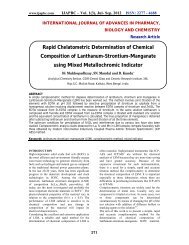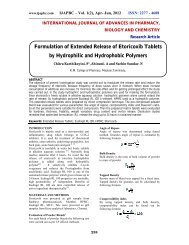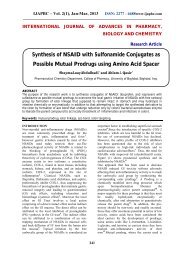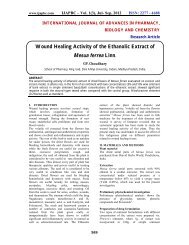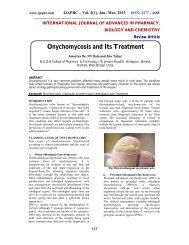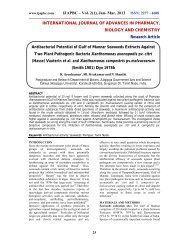Studies on Biosurfactant Production from Lonar Lake's ... - ijapbc
Studies on Biosurfactant Production from Lonar Lake's ... - ijapbc
Studies on Biosurfactant Production from Lonar Lake's ... - ijapbc
You also want an ePaper? Increase the reach of your titles
YUMPU automatically turns print PDFs into web optimized ePapers that Google loves.
www.<strong>ijapbc</strong>.com IJAPBC – Vol. 1(3), Jul- Sep, 2012 ISSN: 2277 - 4688<br />
Hydrocarb<strong>on</strong> degradati<strong>on</strong> potential of the isolate<br />
shows the percent degradati<strong>on</strong> of about 14.46% for<br />
first 24h incubati<strong>on</strong> but as incubati<strong>on</strong> period<br />
increases the percent degradati<strong>on</strong> increases upto<br />
25% but rate of degradati<strong>on</strong> of the hydrocarb<strong>on</strong><br />
decreases as the incubati<strong>on</strong> period increases i.e.<br />
percent degradati<strong>on</strong> rate is inversely proporti<strong>on</strong>al to<br />
the rate of degradati<strong>on</strong> (Fig. 1 and 2)). Although,<br />
the largest applicati<strong>on</strong> of biosurfactant is the oil<br />
industry, for petroleum producti<strong>on</strong> and<br />
incorporati<strong>on</strong> into oil formulati<strong>on</strong>s, oil spill<br />
bioremediati<strong>on</strong>, removal of oil sludge <strong>from</strong> storage<br />
tanks and enhanced oil recovery 18 (Desai and<br />
Banat, 1997) selected isolates will be used for the<br />
bioremediati<strong>on</strong> of the petroleum c<strong>on</strong>taminated site<br />
as the organism has oil degradati<strong>on</strong> capacity.<br />
In the present study, the potential of the<br />
Achromobacter xylosoxidans to produce the<br />
biosurfactant <strong>from</strong> the alkaline L<strong>on</strong>ar Lake is<br />
indicative of the treasure of the diverse industrially<br />
important microorganism which may be exploited<br />
further for commercial point of view. This study<br />
suggests that the L<strong>on</strong>ar Lake is the extreme<br />
envir<strong>on</strong>ment or system for the growth of organism.<br />
<strong>Biosurfactant</strong> obtained <strong>from</strong> organisms isolated<br />
<strong>from</strong> such envir<strong>on</strong>ment might be useful in extreme<br />
envir<strong>on</strong>ments such as temperate marine<br />
compartments and industrial systems where<br />
extremes of temperature are integral elements.<br />
60<br />
Fig. 1: Rate of degradati<strong>on</strong> (mg/ml) of oil<br />
30<br />
Fig. 2: Percent degradati<strong>on</strong> of oil<br />
Rate of degradati<strong>on</strong><br />
50<br />
40<br />
30<br />
20<br />
10<br />
0<br />
56.66<br />
24.79<br />
Rate of degradati<strong>on</strong><br />
(mg/ml)<br />
16.38<br />
11.87<br />
24h 48h 72h 96h<br />
Hour of incubati<strong>on</strong><br />
% degradati<strong>on</strong><br />
25<br />
20<br />
15<br />
10<br />
28.3<br />
25.15<br />
25.79<br />
% Degradati<strong>on</strong><br />
14.46<br />
24h 48h 72h 96h<br />
hour of incubati<strong>on</strong><br />
C<strong>on</strong>clusively, this study has shown that<br />
Achromobacter xylosoxidans, an organism isolated<br />
<strong>from</strong> L<strong>on</strong>ar Lake has ability to survive <strong>on</strong> such<br />
harsh envir<strong>on</strong>ment and also has degradative<br />
potential for oil. Because of the substrate diversity<br />
of this organism it is adjudged as a good candidate<br />
for bioremediati<strong>on</strong> of polluted sites and a potential<br />
resource for surface- active molecules of industrial<br />
importance.<br />
REFERENCES<br />
1. Thakker CD and Ranade DR .<br />
Alkalophilic Methanosarcina isolated<br />
<strong>from</strong> L<strong>on</strong>ar Lake. Curr Sci. 2002; 82:455-<br />
458.<br />
2. J<strong>on</strong>es BE, Grant WD, Duckworth AW and<br />
Owens<strong>on</strong> GG. Microbial diversity of soda<br />
lakes. Extremophiles. 1998;2:191-20<br />
3. Horikoshi K . Alkaliphiles: Some<br />
applicati<strong>on</strong>s of their products for<br />
biotechnology. Microbiol Mol Biol Rev.<br />
1999;63:735-750.<br />
4. Joshi AA, Kanekar PP, Sarnaik S and<br />
Kelkar A. Bacterial diversity of L<strong>on</strong>ar<br />
lake ecosystem. In: Banker SK, Mishra<br />
VR (Eds) Biodiversity of L<strong>on</strong>ar crater.<br />
Anamaya, New Delhi, 2005;71-75.<br />
5. Tambekar DH, Pawar AL and Dudhane<br />
MN . L<strong>on</strong>ar lake water: Past and present.<br />
Nature Envir<strong>on</strong> and Poll Technol. 2010;<br />
9(2):217-221.<br />
6. Joshi AA, Kanekar PP, Kelkar AS,<br />
Shouche YS, Vani AA, Borgave SB and<br />
Sarnaik SS. Cultivable bacterial diversity<br />
of alkaline L<strong>on</strong>ar Lake India. Microbiol<br />
Ecol. 2007;55(2):163-172.<br />
7. Kanekar PP, Sarnaik SS and Kelkar AS<br />
Bioremediati<strong>on</strong> of phenol by alkaliphilic<br />
bacteria isolated <strong>from</strong> alkaline Lake of<br />
L<strong>on</strong>ar, India. J Appl Microbiol (Suppl).<br />
1999;85:1285-1335.<br />
8. Wani R, Kodam KM, Gawai KR and<br />
Dhakephalkar PK. Chromate reducti<strong>on</strong> by<br />
Burkholderia cepacia MCMB-821,<br />
isolated <strong>from</strong> the pristine habitat of<br />
alkaline Crater Lake. Appl Microbiol<br />
Biotechnol. 2007;5:627–632; DOI<br />
10.1007/s00253-007-0862-77.<br />
9. Biria D, Magsoudi E, Roostaazad R,<br />
Dadafania H, Lofti A and Amoozegar<br />
MA. Purificati<strong>on</strong> and characterizati<strong>on</strong> of<br />
novel biosurfactant produced by<br />
Bacillus licheniformis MS3.world J<br />
Microbiol Biotechnol. 2010;26:871-878.<br />
418


